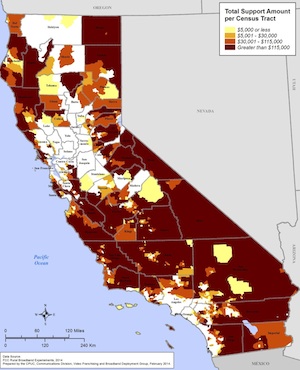
Eligible areas in the California, per the CPUC (click to get a bigger map).
The FCC today released the full details on the rural broadband experiments approved by the commission on Friday. Of legal necessity, the program is limited to regulated telephone companies, although independent ISPs can either partner with one or go through the process to become one.
Eligibility is pretty much what was expected, with one new twist. The money can only be given to “Eligible Telecommunications Carriers” (ETCs) and projects have to include voice service and meet all the rules that pertain to it. But non-ETCs can apply to take part in the experiments and get the designation later. Usually, ETC designations are made by state regulators, such as the California Public Utilities Commission, but the FCC is leaving the door open to making such a designation itself, if a state regulator takes more than 3 months to make a decision.
In that case, though, it’s not yet clear (to me at least, but I’m not a lawyer) that a company would need to first have a certificate of public convenience and necessity (CPCN) from a state regulator (in other words, officially be a regulated telephone company) or if the FCC would preempt that too. It’s an important detail because just getting a CPCN in California can take a year or more.
Winning bidders – and the FCC considers this to be a bidding process – will be picked on the basis of a quantitative cost-effectiveness model, with extra credit for projects that are restricted to tribal lands. The FCC also expects “to select a diversity of projects in terms of geography and technologies”. A total of $100 million is available…
- $75 million (with a max of $20 million per project) for networks capable of delivering 100 Mbps down/25 Mbps up and with at least 25/5 on offer to all customers within the project area. The FCC’s order talks about it in the context of fiber-to-the-premise, but doesn’t limit it to that. Presumably, beefed up VDSL or Docsis 3 cable modem service would qualify too. Pricing and data caps have to be comparable to similar wireline plans in urban areas.
- $15 million for projects that offer a service plan of at least 10 Mbps down/1 Mbps up. That’s a service level that’s often associated with AT&T’s Uverse upgrades on ageing rural copper systems, for example. But fixed wireless and hybrid experiments are also encouraged. The service plan has to allow at least 100 gigabytes of monthly traffic with latency no greater than 100 milliseconds and be reasonably priced, by comparison to FCC benchmarks. The maximum subsidy per project is $7.5 million.
- $10 million, also for 10 Mbps down/1 Mbps up, but specifically earmarked for what the FCC considers to be “extremely high-cost census blocks”. Same specs otherwise, except there’s wiggle room on latency and satellite proposals are allowed. The per-project limit is $5 million.
There is a long list of detailed requirements and qualifications for bidders. I won’t try to summarise it – if you’re interested in applying, it’s best to slog through it yourself. The CPUC previously posted some very helpful information for interested applicants, including maps of eligible areas. Bids are due in 90 days.
